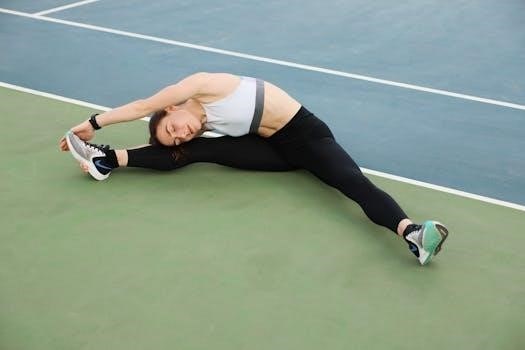Groin Strain Exercises PDF⁚ A Comprehensive Guide
This comprehensive guide provides information about groin strains, including their causes, symptoms, and rehabilitation exercises. It aims to offer a structured approach to recovery, utilizing stretching and strengthening exercises to promote healing and prevent recurrence. Download the PDF for detailed instructions.
Understanding Groin Strains
Groin strains, prevalent in sports involving sudden movements, occur when muscles in the inner thigh or lower abdomen are stretched or torn. These injuries often affect the point where muscle meets tendon. Recurring groin strains can result if predisposing factors, such as weak surrounding muscles, are not addressed. Proper recognition and treatment of the underlying causes are crucial for complete recovery and prevention of future injuries.
Understanding the anatomy of the groin and the mechanics of movements that can lead to strains is essential for effective rehabilitation. Ignoring weakness in the core or hip muscles can prolong recovery and increase the risk of re-injury. This guide will explain the factors contributing to groin strains and promote targeted exercises for long-term stability.

Symptoms of a Groin Strain
The primary symptom of a groin strain is a sudden, sharp pain in the inner thigh or groin region, often occurring during physical activity. The pain can range from mild discomfort to severe debilitating pain, depending on the severity of the tear. Swelling and bruising may also appear in the affected area, indicating tissue damage. Difficulty walking, lifting the leg, or bringing the knees together against resistance are also common indicators.
In some cases, individuals may experience muscle spasms in the groin region. The pain can be aggravated by activities such as running, jumping, or even coughing. It’s crucial to differentiate groin strain symptoms from other conditions, such as hip impingement or hernia, which may present with similar pain patterns. Early and accurate diagnosis is vital for appropriate management and rehabilitation.
Rehabilitation Exercises⁚ An Overview
Rehabilitation exercises for groin strains focus on restoring flexibility, strength, and function. They progress from gentle stretches to resisted movements. These exercises aim to reduce pain, improve range of motion, and prevent future injuries, ultimately returning the individual to full activity.
Early Stage Rehabilitation
The early phase of groin strain rehabilitation focuses on pain management and minimizing further damage. Rest is crucial during this initial period, avoiding activities that aggravate the injury. Ice should be applied for 20 minutes every 2-3 hours to reduce swelling and inflammation; Compression, using a bandage, can also help control swelling. Elevating the groin above heart level promotes fluid drainage.
Gentle range of motion exercises, performed within a pain-free range, can be introduced to prevent stiffness. These may include small, controlled movements of the hip and leg. Isometric exercises, where muscles are contracted without movement, can also be initiated to maintain muscle activation without stressing the injured area. It’s crucial to listen to your body and avoid pushing through any pain.
The goal of this stage is to gradually introduce movement and promote healing, preparing the groin muscles for more demanding exercises in later phases. Progression to the next stage depends on pain levels and the ability to perform early exercises without increased discomfort.

Stretching Exercises for Groin Strains
Stretching is essential for regaining flexibility and range of motion after a groin strain. Gentle stretching exercises should be introduced gradually, focusing on the adductor muscles. Always stretch within a pain-free range to avoid re-injury and promote healing.
Hip Adductor Stretch
The hip adductor stretch is a fundamental exercise for improving flexibility in the groin muscles. To perform this stretch, lie on your back with your knees bent and feet flat on the floor. Gently allow your knees to fall apart, widening your legs to feel a stretch in the inner thigh region.
Hold this position for 15 to 30 seconds, breathing deeply and relaxing into the stretch. Avoid forcing your knees too far apart, as this can cause pain or discomfort. Repeat this stretch three times, allowing for a brief rest between each repetition.
This exercise helps lengthen the adductor muscles, improving their flexibility and reducing tension. Regular performance of the hip adductor stretch can aid in the rehabilitation process following a groin strain and contribute to preventing future injuries. Remember to listen to your body and avoid pushing through any sharp pain.

Strengthening Exercises for Groin Strains
Strengthening exercises are vital for groin strain recovery. These exercises help rebuild muscle strength and stability in the groin and surrounding areas. Start these exercises gradually, focusing on proper form and pain-free movements, to promote healing.
Resisted Hip Flexion
Resisted hip flexion is a key strengthening exercise for rehabilitating groin strains. This exercise targets the hip flexor muscles, which are often affected by groin injuries. To perform this exercise, stand facing away from a door. Secure one end of a resistance band around your ankle on the injured side and the other end to the door.
Keeping your knee straight, slowly lift your leg forward against the resistance of the band. Focus on controlled movement and avoid any sudden jerks. Gradually increase the resistance as your strength improves. This exercise helps to restore strength and improve stability in the hip and groin area.
Remember to perform this exercise pain-free. Start with a low resistance and gradually increase as tolerated. Aim for 3 sets of 10-15 repetitions. Proper execution is crucial to avoid re-injury and promote effective healing of the groin strain.
Hip Abduction and Adduction
Hip abduction and adduction exercises are essential for strengthening the muscles surrounding the hip and groin, promoting stability and recovery after a strain. Hip abduction involves moving your leg away from the midline of your body, while hip adduction involves moving your leg towards the midline.
To perform hip abduction, stand sideways to a door, with your injured leg away from the door. Tighten your thigh muscles and extend your leg out to the side, keeping your knee straight. Return to the starting position in a controlled manner. For hip adduction, stand with your uninjured leg away from the door. Use a resistance band around your ankles to increase the challenge.
These exercises are crucial for restoring balance and strength to the hip and groin muscles, aiding in a full recovery. Aim for 3 sets of 10 repetitions for each exercise, focusing on proper form and controlled movements. Ensure the exercises remain pain-free throughout the rehabilitation process.
Importance of Core Strengthening
Core strengthening plays a pivotal role in the rehabilitation and prevention of groin strains. The core muscles, encompassing the abdominals, lower back, and pelvis, provide a stable foundation for movement and force transfer throughout the body. A weak core can lead to compensatory movements, placing undue stress on the groin muscles and increasing the risk of injury or re-injury.
Engaging in core strengthening exercises enhances overall stability, improving posture and body mechanics. This reduces the strain on the groin muscles during physical activity and daily tasks. Exercises like planks, bridges, and abdominal exercises help build a strong and resilient core.
Furthermore, a strong core facilitates efficient movement patterns, allowing the body to distribute forces effectively. This reduces the risk of overworking the groin muscles and minimizing the likelihood of strains. Integrating core strengthening into a rehabilitation program and maintaining it long-term is essential for a complete recovery and lasting protection against groin injuries.

Return to Activity Guidelines
Returning to activity after a groin strain requires a gradual and progressive approach to minimize the risk of re-injury. These guidelines are designed to help you safely resume your desired activities. Before returning, ensure you have achieved full, pain-free range of motion, adequate strength in the groin and surrounding muscles, and the ability to perform functional movements without discomfort.
Begin with low-impact activities, such as walking or light jogging, gradually increasing the intensity and duration as tolerated. Avoid activities that place excessive stress on the groin, such as sprinting or cutting movements, until you can perform them without pain. Incorporate sport-specific drills to prepare your body for the demands of your chosen activity.
Pay close attention to your body’s signals and immediately stop if you experience any pain or discomfort. It is crucial to listen to your body and not push yourself too hard, too soon. A slow and steady approach is more effective than rushing back, which can lead to setbacks. Consider consulting with a physical therapist or healthcare professional for personalized guidance and monitoring throughout your return to activity.